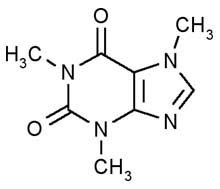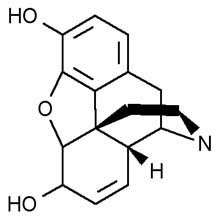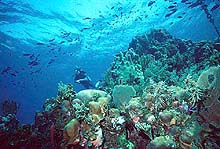
Competition for resources is intense in habitats such as reefs. Many of the sessile invertebrates produce natural products to help them be more competetive. Click image for larger view. Photo: John Reed
What is a Natural Product ?
Amy E. Wright, Ph.D.
Director, Division of Biomedical Marine Research
Harbor Branch Oceanographic Institution
Every cell is made up of chemicals. Substances such as lipids make up the cell membrane. Proteins, such as actin and tubulin, give the cell shape. Other proteins (enzymes) carry out chemical reactions within the cell. All of these types of chemical compounds (proteins, lipids, triglycerides, sugars, cholesterol, polysaccharides, amino acids, etc.) must be present to allow the cellular machinery to work. Without these substances called “primary metabolites,” the individual cells and thus, the organism, cannot survive.
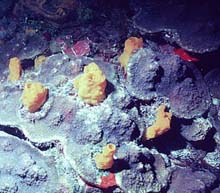
The sponge Siphonodictyon can grow through coral heads. It makes compounds that can kill the coral, allowing it to colonize more space. Click image for larger view. Photo: John Reed
In contrast, "secondary metabolites"—low-molecular-weight compounds that are synthesized by a plant, microorganism or animal—are not essential to sustain life within the cell. Presumably, they confer an evolutionary advantage. These compounds (e.g., caffeine, morphine), commonly known as "natural products," are of great interest to chemists participating in the Islands in the Stream 2002 expedition.
It takes a lot of energy to produce a natural product, so, why do the organisms bother?
National Products in the Marine Environment
To better understand this process, we need to look at how these animals grow and the habitats in which they live. On this expedition, we will be working primarily with invertebrates, such as soft corals, sponges, bryozoans and ascidians. If you look at most reefs, you can see that almost every square inch of space is inhabited. Competition for space and food is enormous.
Most of the animals are sessile as adults, meaning they grow attached to something else, perhaps a rock or another animal. There are a few invertebrates, such as sea slugs, that can move around, but they would not set any Olympic speed records. The slowest fish are hundreds of times faster. As larvae, most of these invertebrates can get around. But once they enter their juvenile phase, they select a home, settle there, and metamorphose into adulthood if they choose an advantageous spot. In general, they can’t get up and move if the neighborhood gets bad. This presents a number of problems:
• How can they defend themselves against things that want to eat them?
• How can they keep other animals from moving into their space?
• How can they find a mate if they can’t go looking?
• How can they protect themselves from bacterial, fungal or viral infections?
One way to accomplish all of these tasks is to use secondary metabolites. If you taste bad, smell bad or are toxic, you are less likely to get eaten. Even if a fish takes a bite out of the sponge, the rest of it can survive, and many fish eventually learn what is and is not good. The same applies to keeping the neighbors from moving in on you. Most of these animals are filter feeders and so compete with each other for the same food source. It makes sense to keep the neighbors away. Some of these animals, such as the sponge, even go so far as to produce toxic compounds that eventually kill off its unlucky cohabitants.
The aforementioned sponge, Siphonodictyon coralliphagum, exhibits this behavior. It bores through coral heads and produces a toxic substance that can kill the coral, allowing the sponge to colonize more space.
Reproduction also can be a tough proposition if you cannot move around and you live in a water environment. Many of the sessile invertebrates are broadcast spawners, meaning that at certain times of the year, they simultaneously release sperm and eggs into the water column. Is it just chance that allows the sperm to find the eggs? For at least one soft coral that lives in Australia, it has been demonstrated that a series of natural products present in the eggs actually act as sperm attractants
Natural products can act as chemical "lighthouses" to guide the larvae back to the adult organism. The larvae can sense these compounds and actively swim back to the parent, thus insuring that they settle in a suitable habitat. On the other hand, these compounds may act to stop the larvae of other species from settling on top of the original inhabitants.
Just like mammals, marine organisms can suffer from infections because bacteria, fungi and virus are all present in marine habitats. Most of these animals have primitive immune systems, if any. Many secondary metabolites are strong antibiotics, antifungal and/or antiviral agents, and this may be another reason why they are produced.
As for most of the compounds we encounter, we do not fully understand why they are present. Fortunately, however, we do not have to understand why they are there. It is enough that they exist.
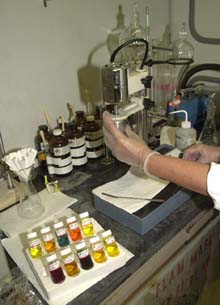
A virtis grinder is used to grind small pieces of each sample with ethyl alcohol. This makes an extract used in biological and chemical testing. Click image for larger view.
Extracting Natural Products
In the process of looking for new and useful natural products, the chemists on the expedition will prepare extracts of each of the organisms we collect. Once we return to the laboratory at HBOI, these extracts will be used in our biological screening program. At sea, we will analyze the chemicals in them.
If you drink tea or coffee, you are familiar with the extraction process. For these drinks, we pour boiling hot water over dried and ground-up tea leaves or coffee beans. The hot water “extracts” the various chemicals (e.g., flavoring and natural products such as caffeine) present in the dried plant tissue, resulting in a good-tasting and chemically stimulating beverage.
On the ship, we prepare extracts of the plants and invertebrates we collect by adding some ethyl alcohol and grinding them up in a high-speed blender. We use alcohol instead of hot water because some of the compounds present in our samples do not respond well to treatment with boiling hot water. After trying many different organic solvents, we have found that ethyl alcohol provides us with excellent extraction efficiency and is safe for both the chemist handling the extracts and the cells and enzymes we eventually use to test them.
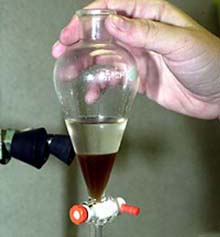
The separatory funnel shown here contains water (bottom) and heptane (top). Due to their dissimilarity in structure, the two liquids form two layers. This can be used to separate the compounds (natural products) found in samples. Click image for larger view.
Chemists on the expedition also will be using chromatography to detect new natural products. Chromatography essentially is the separation of complex mixtures by percolation through a series of adsorbing media, which separates the components of the mixture into distinct layers. Two variants of chromatography— thin layer chromatography (TLC) and high performance liquid chromatography (HPLC)— will be used to determine if the organisms we have collected are rich in natural products. We can also determine if different organisms contain the same compounds.
On this expedition, we will use chromatography to separate the compounds we collect. We can look at the pattern of compounds to see if we have anything that may have exciting prospects.
Sign up for the Ocean Explorer E-mail Update List.















































